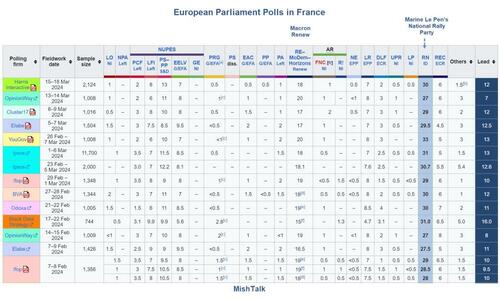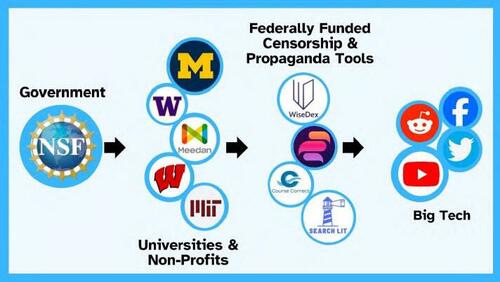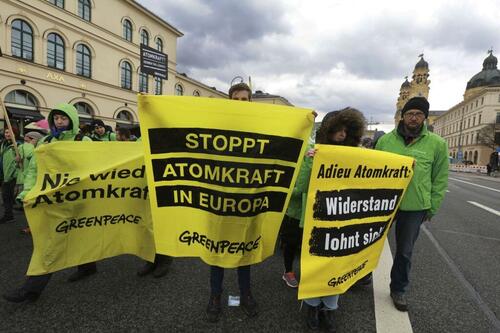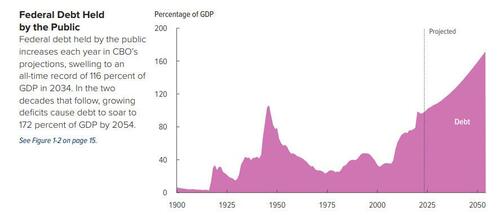The good thing about politics is that there always seems to be a way to pass the hot potato to the next guy although of course eventually the game has to stop.
The Maastricht rules have always been wishful thinking. Without transfer mechanism between different countries, you cannot maintain a unique currency and interest rate for very long if nobody obeys the rules. Now not only are most countries not obeying the rules but they are creating extra hurdle like the green agenda or support for Ukraine which makes even the pretense ludicrous.
As we approach the end, expect extreme behavior and statements from leaders like Macron. France like England lives in the delusion of its former grandeur. The reconciliation between wishful thinking and reality will be painful.
Authored by Mike Shedlock via MishTalk.com,
The EU never enforced its Growth and Stability Pact or Maastricht Treaty rules. The crisis is coming to a head with France and Italy in the spotlight. The first casualty will be Green policy.
Image composite by Mish from the European Commission Compliance Tracker
Compliance Rules
Deficit rule: a country is compliant if (i) the budget balance of general government is equal or larger than -3% of GDP or, (ii) in case the -3% of GDP threshold is breached, the deviation remains small (max 0.5% of GDP) and limited to one year.
Debt rule: a country is compliant if the general government debt-to-GDP ratio is below 60% of GDP or if the excess above 60% of GDP has been declining by 1/20 on average over the past three years.
Structural balance rule: a country is compliant if (i) the structural budget balance of general government is at or above the medium-term objective (MTO) or, (ii) in case the MTO has not been reached yet, the annual improvement of the structural balance is equal or higher than 0.5% of GDP, or the remaining distance to the MTO is smaller than 0.5% of GDP.
Expenditure rule: a country is complaint if the annual rate of growth of primary government expenditure, net of discretionary revenue measures and one-offs, is at or below the 10-year average of the nominal rate of potential output growth minus the convergence margin necessary to ensure an adjustment of the structural budget deficit in line with the structural balance rule.
Deficit Disaster Zones
France and Italy are major disasters right now on the budget deficit rule. France has a budget deficit of 7 percent and Italy 5 percent.
France needs to reduce its deficit by a whopping 4 percent of GDP!
Neither Italy nor Greece should never have been allowed in the EMU (European Monetary Union – Eurozone) in the first place.
Greece has a debt-to-GDP ratio of 170 percent. The target is 60 percent.
But the lead chart tells the picture. Only the Scandinavian countries are in compliance.
Looser Rules Postpone the Crisis
On February 10, the EU agreed to Looser Fiscal Rules to Cut Debt, Boost Investments.
The latest revamp of two-decades-old rules known as the Stability and Growth Pact came after some EU countries racked up record high debt as they increased spending to help their economies recover from the pandemic, and as the bloc announced ambitious green, industrial and defense goals.
The revised rules allow countries with excessive borrowing to reduce their debt on average by 1% per year if it is above 90% of gross domestic product (GDP), and by 0.5% per year on average if the debt pile is between 60% and 90% of GDP.
Countries with a deficit above 3% of GDP are required to halve this to 1.5% during periods of growth, creating a safety buffer for tough times ahead.
Defense spending will be taken into account when the Commission assesses a country’s high deficit, a consideration triggered by Russia’s invasion of Ukraine.
The new rules give countries seven years, up from four previously, to cut debt and deficit starting from 2025.
Note that the EU can tweak enforcement but not the baseline Stability and Growth Pact targets themselves without unanimous agreement, and a new treaty.
With that background, let’s look ahead to the crisis that looms as described by Eurointelligence.
Europe’s Next Financial Crisis
We would like to alert our readers to a theme that has been preoccupying us for a while – the possibility of another financial crisis in Europe. We have generally been restrained in our warning of financial crises. The main exception was the global financial crisis and its cousin, the euro area’s sovereign debt crisis. Fifteen or so years later, we see another financial crisis ahead here in Europe: a crisis of the European social and political model with deep consequences for fiscal and financial stability.
The canary in the coalmine is the overshooting budget deficits in France and Italy, at over 7% and over 5% for 2024 respectively. These numbers are a symptom, not a cause. Behind them lies a lack of economic growth needed to sustain Europe’s social model. Germany’s fiscal policy could not be more different than that of France or Italy, and yet Germany is afflicted by the exact same problem.
The European model was powered by oligopolistic industrial companies, which were heavily supported by the state through regulation that tilted the level-playing field in their favor. The German car industry is a classic example, but everybody did this.
What is killing this model now is a shift in technology and geopolitical fragmentation. Of the two, we would argue the first is the more important. More and more functions in our lives that were previously the realm of purely mechanical processes are nowadays wholly or partially digitalized. Barriers of entry have collapsed. China went from zero to the world leader in electric cars.
European companies no longer generate sufficient profits to fuel the social model – and to fund long-term research. It is no surprise that Europe has only very few tech companies. In short, Europe’s oligopolistic old-tech model no longer works in a digital world. We have been reporting on the attempts by the EU to stem against technological developments through regulation. But this is a way of addressing symptoms, not causes.
After the multiple global shocks of this decade, the consequences of Europe’s technological decline translate into lower potential growth rates. Italy came first. Its productivity growth has been near zero since it joined the euro. The UK’s productivity growth slumped after the global financial crisis, and never recovered since. Germany’s productivity growth is unlikely to recover, even if the economic cycle does. The German Council of Economic Experts see a potential growth of around 0.5% until the end of the decade. With productivity growth that low, Europe’s model has become financially unsustainable. It is unsurprising that the political system is fragmenting everywhere. The argument for sustained deficits, in France for example, is that you need them to keep Marine Le Pen out of power. This means they will persist.
We have a fiscal crisis ahead, caused by a combination of falling productivity growth and political gridlock. Technology is the main cause of the decline. Geopolitics is what accelerated it. The solutions we have been advocating over the years – a joint fiscal capacity, a capital markets union, joint defense procurement to neutralize the rise in defense spending – are further away than ever. Unless one of these parameters change, a financial crisis is a very plausible scenario.
Spotlight France
France has a budget deficit of 7 percent but wants to fund a European army to fight Russia.
How is that supposed to work?
Spotlight Green Fantasies
The EU has adopted ambitious Green policies that will cost much more money than has been budgeted.
How is that supposed to work?
Targets Won’t Be Met
You can take those Green targets and throw then into the ashcan of ideas that never should have been set in the first place.
Even if you give France 7 years to be deficit compliant, how is France supposed to cut back a whopping 4 percent of GDP?
What’s the Basic Problem?
Eurointelligence says “Technology is the main cause of the decline. Geopolitics is what accelerated it.”
Technology is not the problem. The Maastricht treaty that created the Eurozone is flawed. And it cannot be fixed without unanimous agreement.
Given productivity and work rule differences, one interest rate set by the ECB cannot serve Italy, France, Greece, and Germany.
Add to that, EU nannycrat rules. The EU is more interested in cracking down on Google (Now Alphabet GOOG), Apple (AAPL), Facebook (now Meta Platforms META), and Microsoft (MSFT) for alleged monopolies than developing anything.
The EU Is Dysfunctional
In a single word, the EU is dysfunctional. That’s the problem, not technology. The Maastricht treaty itself is a big part of the reason the EU is dysfunctional. The Euro itself, with one common interest rate, is fundamentally flawed.
Companies like Alphabet, Meta, Microsoft, and Apple could not exist in the EU because in the name of competition and diversity, the EU would kill them before they ever got big enough to matter.
EU rules make it impossible to fix the basic problem. So the EU has resorted to nannycrat rules to regulate US and Chinese companies instead of fixing anything.
Technology, including AI, and geopolitics is now accelerating the basic problem, the EU is dysfunctional by treaty. It’s showing up in polls everywhere.
European Parliament Polls in France
EP France Polls from Wikipedia
Marine Le Pen’s National Rally is clobbering Renew/Modem by a whopping 12 percentage points, 30-18.
This chart is for France only, not the entire parliament, but it reflects on French President Emmanuel Macron’s sinking popularity and the sinking centrists in general.
A War Economy
As a way to create jobs, EC President Charles Michel promotes a war economy.
In a preposterous proposal to deal with growth, The European Council President Calls on Europe to Switch to a War Economy
I have a suggestion. Let US senator Lindsey Graham and EC president Charles Michel lead the charge.
Instead of fixing Germany’s aging infrastructure, attempting to compete with the US on AI, or competing with China on anything, EC President Charles Michel promotes war as growth.
It’s Time for a New Strategy
Please note German Chancellor Olaf Scholz is refusing to send Taurus cruise missiles to Ukraine.
On March 16, I commented Ukraine Won’t Win the War, It’s Time for a New Strategy
There’s Solidarity, Then There’s Solidarity
Poll after poll shows support for Ukraine. Every one of then is flawed because they fail to ask “how much are you willing to pay.”
There’s solidarity in the EU, but it stops with wheat and weapons. In the US, Biden is desperate for the war to go on. But he still has no goal. Is Biden’s goal the same as Zelensky’s: “The war will not be over as long as Crimea is occupied.”
We don’t know because Biden won’t say. Biden also will not say how much he is willing to commit. Is it another $150 billion or is it $1 trillion or more?
Meanwhile, prepare for carnage of the center, Greens, and warmongers in the next European Parliament elections.
A fiscal crisis awaits. The first casualty will be Green energy policies.












